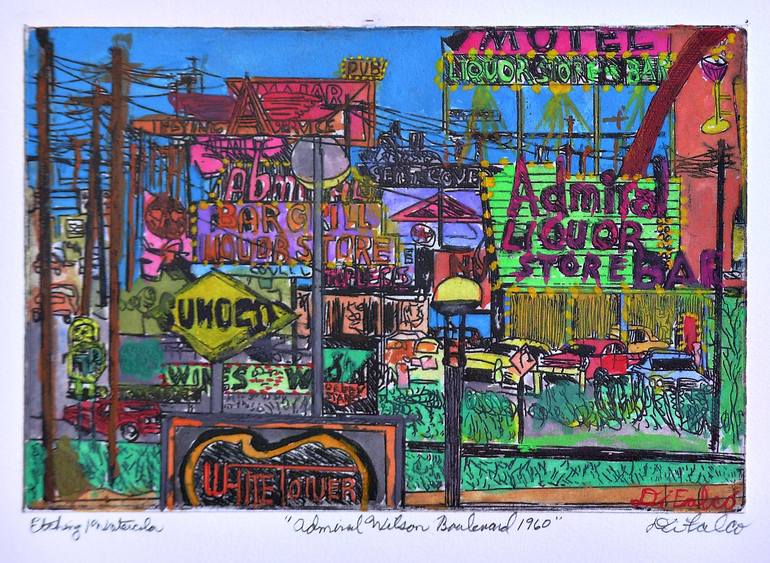


VIEW IN MY ROOM
Admiral Wilson Blvd 1960 Painting
United States
Painting, Watercolor on Paper
Size: 16 W x 12 H x 1 D in
Ships in a Box
Artist Recognition

Artist featured in a collection
About The Artwork
This artist’s proof of an etching by Di Falco is enhanced with watercolors and depicts a section of his home city Camden, New Jersey. He employed the studio techniques of intaglio, aquatint, and drypoint on a zinc etching plate and developed the image in four Nitric acid baths. This hand printed work—executed on a Charles Brand industrial printing press made in New York City—was printed with oil base etching inks on RivesBFK white paper, both manufactured in France. The print size is about 11 by 15 inches and comes in a frame and archival mat (about 12 by 16 inches). The etching was trimmed and mounted on another piece of RivesBFK white paper. Di Falco published and printed the work at Fleisher Art Memorial’s Center For Works On Paper in Philadelphia, Pennsylvania, as part of their OPEN STUDIO IN PRINTMAKING. Fleisher Art School is associated with The Philadelphia Museum of Art. NARRATIVE: Admiral Wilson Boulevard, a two-mile section of U.S. Route 30, opened in 1926 in Camden, New Jersey. It was the first “auto strip” in the United States, originally called Bridge Approach Boulevard, until being renamed in 1929; The Rear Admiral Henry Braid Wilson was a Camden native who had served in the Spanish-American and First World Wars. The road had a noteworthy bearing on the development of the South Jersey suburbs and Camden City in the twentieth century. The area even included the first drive-in movie theater in the world. The artist states that, “My mother shot this photo in 1960 from her car. It illustrates how the lack of urban planning creates an environment devoid of beauty.”
Details & Dimensions
Painting:Watercolor on Paper
Original:One-of-a-kind Artwork
Size:16 W x 12 H x 1 D in
Frame:Other
Ready to Hang:Not applicable
Packaging:Ships in a Box
Shipping & Returns
Delivery Time:Typically 5-7 business days for domestic shipments, 10-14 business days for international shipments.
Handling:Ships in a box. Artists are responsible for packaging and adhering to Saatchi Art’s packaging guidelines.
Ships From:United States.
Have additional questions?
Please visit our help section or contact us.
United States
Imagery and storyline—both vital components of my creative process—enable me to create a form of visual poetry. Consequently, photography is intricate to my artistic strategy, especially with regard to my etchings. In view of this, many of my printed images—accomplished via the studio techniques of intaglio, aquatint, drypoint, and Chine collè—originate from my own photographs, as well as ones I uncover during research into the archives of academia, historical societies, and museums. Upon locating a scene that fascinates me, I first sketch a few original drawings of the likeness, and next transfer that drawing onto my prepared zinc etching plate. NOTE: In my etchings that incorporate the Chine collè process, I use mulberry bark paper from Thailand, which is infused with Japanese kozo threads. The paper is also treated with methylcellulose. I endeavor to establish links between the metaphysical and physical worlds . . . between the realms of dream and reality . . . and between the natural and the fabricated. In a sense, I believe that art unveils everything that we mask behind our assumptions and biases . . . or rather, those realms we neglect—or refuse—to perceive. My label for our failure to examine these areas is, “The Phenomenology of Non-Connectedness", which I blame on today’s communicational tools such as Social Media, the Internet, texting on smart phones, and “tweeting”. MY ETCHING TECHNIQUE I work on metal etching plates treated with both hard and soft grounds. These grounds consist of mineral spirits, beeswax, oil of spike lavender, and other natural substances. After these grounds dry, I draw images with needles and other tools onto the plate. Next, the exposed areas are “etched into” the zinc or copper plate in a bath of Nitric Acid and spring water. An artist’s proof in then printed after the plate is cleaned; Moreover, two to seven additional plate workings, acid baths, and proof printings occur before my desired effect is obtained. When satisfied with my end result, I apply oil based etching ink onto the clean plate and then remove the excess ink with several wipes. Next, I align my etching plate onto the printing press bed and cover it with papers and press blankets. Finally, the plate goes through the press to obtain my print. This process is repeated until all editions are created. I usually create three to five editions of five or six etchings for each one of my plates.
Artist Recognition

Artist featured by Saatchi Art in a collection
Thousands Of Five-Star Reviews
We deliver world-class customer service to all of our art buyers.
Global Selection
Explore an unparalleled artwork selection by artists from around the world.
Satisfaction Guaranteed
Our 14-day satisfaction guarantee allows you to buy with confidence.
Support An Artist With Every Purchase
We pay our artists more on every sale than other galleries.
Need More Help?